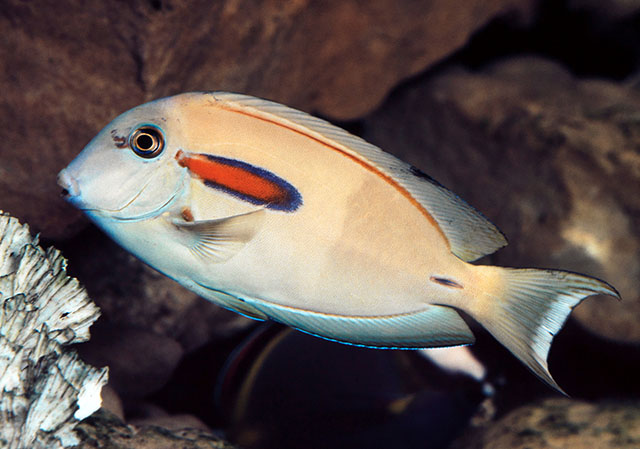| Acanthuridae (Surgeonfishes, tangs, unicornfishes), subfamily: Acanthurinae |
| 35 cm TL (male/unsexed); max. reported age: 33 years |
|
reef-associated; marine; depth range 3 - 46 m |
| Pacific Ocean: Christmas Island and Cocos-Keeling Islands in the eastern Indian Ocean to the Hawaiian and Tuamoto islands, north to Japan, south to Lord Howe Island. Replaced by Acanthurus tennenti in the Indian Ocean (Ref. 37816). |
|
Dorsal spines (total): 9-9; Dorsal soft rays (total): 23-25; Anal spines: 3-3; Anal soft rays: 22-24. Body of adult dark grayish brown; juveniles yellow; posterior to upper end of gill opening is a bright orange horizontal band, with purplish black border. Head and anterior half of body usually abruptly paler than the posterior half. Anterior gill rakers 24-28; posterior 23-27. Large adult males (about 17 cm) with more definite convexity of snout profile.
Description: Characterized further by having caudal spine length of 2.5 in head length; greatest depth of body 2.0-2.4 in SL (Ref. 90102). |
| Inhabit seaward reefs, in areas of bare rock or mixed rubble and sand, from 9 to at least 46 m depth; juveniles inhabit protected bays and lagoons, singly or in small groups in as little as 3 m (Ref. 1602, 48637). Benthopelagic (Ref. 58302). Adults occur singly or in schools and feed on surface film of detritus, diatoms, and fine filamentous algae covering sand and bare rock (Ref. 1602). Rarely poisonous (Ref. 4795). |
|
Least Concern (LC); Date assessed: 04 May 2010 Ref. (130435)
|
| harmless |
Source and more info: www.fishbase.org. For personal, classroom, and other internal use only. Not for publication.

